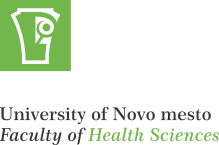Comparing Assertiveness among Students of Nursing and Mechanical Engineering
Comparison of Lifestyles between Students of Healthcare and Non-Healthcare Study Fields
Keywords:
students, healthy lifestyle, health promotion, occupational therapyAbstract
During study period, many young people begin to live their own lifestyle, and move away from their homes. However, their lifestyle starts to mirror their obligations at the faculty, students work, and other factors. Healthy lifestyle includes balanced nutrition, physical activities, health responsibility
and stress management. The purpose of our research was to determine the differences in lifestyles of students of both healthcare and non-healthcare study fields. The sample included 562 students of different Slovenian faculties, with the average age of 22 (±2.2) years. We used the »Health-Promoting Lifestyle Profile II« questionnaire, translated into Slovene. The HPLP II contains 52 questions about spiritual
growth, health responsibility, physical activity, nutrition,
interpersonal relations and stress management. We found out that students of healthcare study fields have a healthier lifestyle than others. Healthcare professionals can promote a healthy lifestyle to the rest of the population through their own example and expertise gained during their studies.
References
Brenčič, H. (2011). Mladi naj se odžejajo s športom ne alkoholom. V: Zbornik 24. Posveta športnih pedagogov Slovenije. Zveza športnih pedagogov Slovenije, str. 5–7.
Can, G., Ozdilli, K., Erol, O. idr. (2008). Comparison of the health-promoting lifestyles of nursing and non-nursing students in Istanbul, Turkey. Nursing & Health Sciences, 10, No. 4, pp. 273–280.
Caspercen, C. J., Pereira M. A. in Curran K. M, (2000). Medicine & Science in sports & exsercis. American College of Sports Medicine. Pridobljeno dne 27. 12. 2016 s svetovnega spleta: https://www.researchgate.net/profile/Mark_Pereira2/publication/12328111_Changes_
in_Physical_Activity_Patterns_in_the_United_States_by_Sex_and_Cross-Sectional_Age/links/546639d40cf25b85d17f5cee.pdf.
Hoyer, S. (2005). Pristopi in metode v zdravstveni vzgoji. Ljubljana: Visoka šola za zdravstvo.
Janse Van Rensburg, C. and Surujlal, J. (2013). Gender differences related to the health and lifestyle patterns of university students. Health SA Gesondheid, 18, No. 1. Pridobljeno dne 12. 1. 2017 s svetovnega spleta: http://www.hsag.co.za/index.php/HSAG/article/view/735.
Kielhofner, G. (2008). Model of human occupation: theory and application. Baltimore; Philadelphia: Lippincott Williams: Wolters Kluwer Health.
Kuhar, M. (2015). Mladinsko delo in promocija zdravega sloga. Služba Vlade Republike Slovenije za razvoj in evropsko kohezijsko politiko, str. 4–5.
Lebar, C. in Marušič, V. (2016). Primerjava zdravega življenjskega sloga dijakov splošne gimnazije in srednje zdravstvene šole. 4. mednarodna znanstvena konferenca Za človeka gre: družba in znanost v celostni skrbi za človeka. Maribor, 11.–12. marec, 2016. Maribor: Alma Mater Europea – ECM, str. 66–74.
Mack, E. D., Wilson, P. M., Lightheart, V., Oster, K. and Gunnell, K. E. (2009). Healthy Campus 2010: Physical activity trends and the role information provision. Journal of Physical Activity and Health, 6, No. 4, pp. 1–10.
Mehri, A., Solhi, M., Garmaroudi, G., Nadrian, H. and Sighaldeh, S. S. (2016). Health promoting lifestyle and its determinants among university students in Sabzevar, Iran. International Journal of Preventive Medicine, 7, No. 1, pp. 6–8.
Modic, J., Berglez, S. in Beočanin, T. (2011). Zdravje mladih. Mladinski svet Slovenije: Ljubljana Pridobljeno dne 7. 12. 2016 s svetovnega spleta: http://www.mladi-in-obcina.si/wp-content/uploads/Knjiznica/programski-dokumenti-MSS/zdravje_mladih_web.pdf.
Nassar, O. S. and Shaheen, A. M. (2014). Health-Promoting Behaviours of University Nursing Students in Jordan. Health, 6, No. 19, pp. 2756–2763.
Sakurai, H. (2003). Healthy Japan 21. Japan Medical Association Journal, 46, No. 2, pp. 47–49.
Schmidt, M. (2012). Predictors of Self-Rated Health and Lifestyle Behaviours in Swedish University Students. Global Journal of Health Science, 4, No. 4, pp. 2–10.
Scott, A. H. (1999). Wellness works: Community Service Halth Promotion Grups Led by Occupational Therapy Students. American Journal of Occupational Therapy, 53, No. 6, pp. 566–574.
Stanojević, S. M. (2009). Zdrav Življenjski slog: gradivo za 2. Letnik. Ljubljana: Zavod IRC.
SURS (2015). Mednarodni dan študentov. Pridobljeno 2. 2. 2017 s svetovnega spleta: http://www.stat.si/statweb/prikazi-novico?id=5590&idp=17&headerbar=15.
Tirodimos, I. , Georgouvia, I., Savvala, T. N., Karanika, E. and Noukari, D. (2009). Healthy lifestyle habits among Greek university students: differences by sex and faculty of study. East Mediterr Health Journal, 15, No. 3, pp. 725–727.
Truden - Dobrin, P. (2009). Kazalniki zdravja mladostnic in mladostnikov. Farmacevtski vestnik, 60, št. 4, str. 223–225.
USC Mrs. T. H. Chan Division of Occupational Science and Occupational Therapy (2016). Pridobljeno s svetovnega spleta dne 12. 12. 2016: http://chan.usc.edu/patient-care/faculty-practice/about.
HSS- U. S. Department of Health and Human Services (2000). Healthy People 2010: Understanding and Improving Health. Washington, DC: U.S. Government Printing Office.
Varela, M. V., Cancela, J. M., Ayan, C., Martin, V. and Molina, A. (2012). Lifestyle and Health among Spanish University Students: Differences by Gender and Academic Discipline. Public Health, 9, No. 8, pp. 2729–2738.
Walker, S. N., Sechrist, K. R. and Pender, N. J. (1995). Health-Promoting Lifestyle Profile II. Pridobljeno dne 21. 11. 2016 iz svetovnega spleta: http://www.brandeis.edu/roybal/docs/Health-Promoting %20Lifestyle %20Profile %20II %20_website_PDF.pdf.
Wang, D., Xing, X. H. and Wu, X. B. (2013). Healthy Lifestyles of University Students in China and Influential Factors. The Scientific World Journal, 2013, No. 6, pp. 7–8.
Wei, C. N, Harada, K., Ueda, K., Fukumoto, K., Minamoto, K. and Ueda, A. (2012). Assessment of health-promoting lifestyle profile in Japanese university students. Environ Health Prev Med, 17, No. 3, pp. 222–227.
WHO (2013). The European health report 2012: Charting the way to well-being, pp. 5–6.
Žabkar, B. in Dobrinja, D. (2009). Zdrav življenjski slog mladih družin. Posebnosti pediatrične zdravstvene nege socialno ogroženega otroka in mladostnika. Pridobljeno 3. 12. 2016 iz svetovnega spleta: https://www.zbornicazveza.si/sites/default/files/kongres_zbn_7/pdf/123B.pdf.





